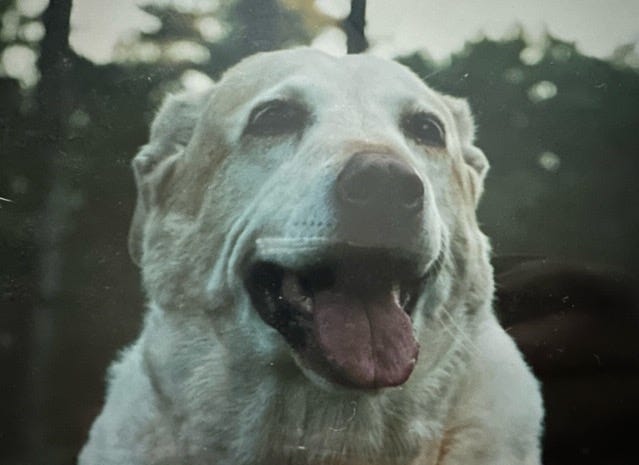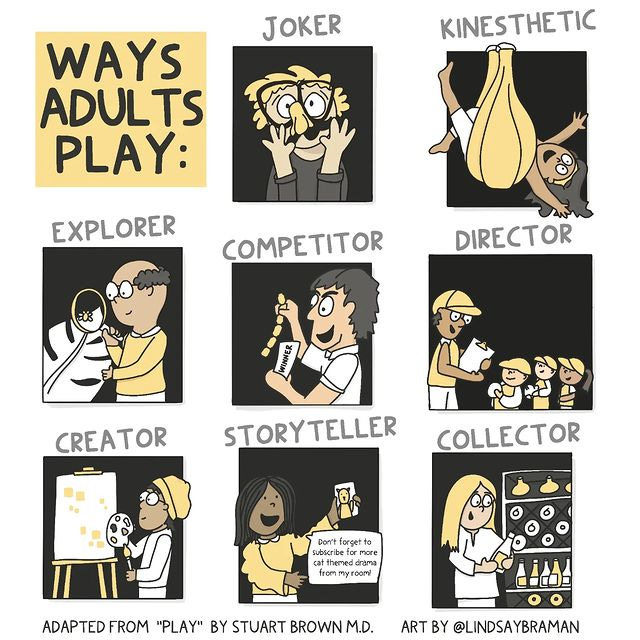Remembering to play 🥰
My word of the year 2023: Play(!)
My parents got our childhood dog Maizy when I was almost one. She was a squat yellow Labrador with a pink nose, soft little ears that were just slightly too small for her body, and the friendliest smile. All dogs are good dogs, but man was she a good dog.
Like everyone else in the family, Maizy had household roles and responsibilities. Every morning her job was to fetch the newspaper. Around 9am she’d head out on the road with my dad as he made runs to auto repair shops and garages across eastern Massachusetts from his Snap-On tool truck. With every stop, she’d hop out to hold up her end of the partnership: greet customers with a smile and help him sell. At the end of the day, they’d return home and she was rewarded with her favorite activity of the day, Frisbee Time (!!), performing stunning acrobatic jumps to catch the flying disk mid-air — 25 or 50 or 100 or more tosses. She’d have gone for more, though.
I’m not sure I recognized the degree of physical activity that Maizy got in a day until I brought Maddie home. But I’m realizing now! Maddie’s 9 months old and I’m coming to learn what motivates her, the type of reward that will help us bond, enforce good behavior, and help her regulate so she can find her role in the household. Turns out, it’s not so different from Maizy. Some dogs are motivated by food, some need praise, and some are driven by pets and physical affection. All of those are fine and good for labs, but Maddie’s (and Maizy’s) favorite will be the inspiration for my new word of the year: Play.
The Need for Play
Play is an entire category on the Center for Nonviolent Communication’s Needs Inventory List, which I’ve reflected on in the past, and play is fundamental to our development as mammals. According to The National Institute for Play, we can see through animal play research that the motivation to play is hardwired in the survival centers of the brain: “Neuroscience has shown that when the cortex of small mammals is removed, they play just as actively as peers with an intact cortex. But as the animals age, those without a cortex do not develop the ability to relate to their peers and never mate. When threatened by a larger animal, both groups of animals will hide, but those without a cortex remain in hiding long after the threat has passed; they will die of hunger hiding from a predator that left long ago.”
I’ll admit that I relate to the feeling of staying in hiding long after the threat has passed. I spent much of my winter of discontent doing this.
Play is a survival mechanism and evolutionarily advantageous for animals (including us). It helps mammals to test out various scenarios to prepare for real-life dangerous ones and develop social skills needed for forming communities and mating. The NIFP discusses how important play is for children, forming the basis of fundamental life skills, instilling that perseverance can be fun, supporting focus, generating optimism, building confidence, and increasing empathy. Nonetheless, we tend to forget that play still matters as adults. This year, I want to embrace the notion of a season of spring, and with it invite more play into my life.
We All Play in Different Ways
When I was visiting my family and friends for Christmas, I was reminded how diverse play styles can be. My 8-year-old nephew CJ is a collector: trains, Lego sets, Pokemon cards. Cameron is in a “rough-and-tumble” play phase, a little bulldozer who loves to wrestle, run, create havoc and destroy CJ’s Lego creations. My friend Alberto’s daughter seemed drawn to creative and narrative play, immediately engaging me to read a book and later draw with her. And me? Well, after a year that felt kind of heavy, I’ve needed to remind myself what play even is for me.
As a kid, sports were never my thing. I wasn’t competitive and I didn’t have a strong interest in strategic games. I didn’t obsess over collecting the Beanie Babies my mom would buy so much as set them up as characters in stories I’d create in detail. Play with Barbies was all about the drama of their interconnected lives. We’d use the family’s Sony camcorder to produce cooking shows and perform and record plays. My favorite way to spend an afternoon was to ride my bike to a trail behind my neighbor’s yard and live in my imaginary worlds.
It’s no surprise that my play style hasn’t changed much since I was a kid. According to the “Play Style” quiz developed by Lindsay Braman, my play personality is Storyteller: Some adults play through storytelling. They feel the release of play through telling and listening to stories. They are the authors and the novel readers, but more so – they are people who craft narratives from ordinary life.
People who play through storytelling are the folks who can see an ordinary situation and transform it into a fascinating narrative, weaving fact with imagination in a way that expends energy in a playful (and yet almost inevitably professionally useful) way.
At times I get too caught up in the “professionally useful” aspect of this description. I wrote down my own definition of play in my journal while working on my goal-setting exercises for the year on retreat which looked like this:
The experience of feeling openness to spontaneity and the act of becoming lost in the moment, absorbed in joy and the unknown, unencumbered by a desire for potential outcomes.
It seems that our own definition of play will likely be shaped by our play personality since play can look so different for us all. It also explains why wrestling with my dog doesn’t feel like play to me, but taking her for a peaceful walk while daydreaming actually does.
My 2023 Goals & “Play”-list
To cast a game plan for the year ahead and get intentional about my word, I came up with four goals for my year around the idea of play:
1. Write something every day that does not have immediate "market value". * Texts and business emails don't count; journal entries do!
2. Dance every day to music I love. This can be shower dancing, car dancing, living room dancing, and hopefully some actual dance classes which I'd like to take. I love a song with a story most.
3. Take myself on an "artist's date" every week. Allow myself to daydream, people watch, journal, write, make playlists, listen to music, get lost in other's stories, or just read a book in a new place.
4. Start a podcast. This just feels like fun to me. I’ve been meaning to make one for a while, and I love the idea of storytelling in this medium. So I’m going to try!
What’s Your Play Style?
If you’ve felt bogged down lately, I’d encourage you to take yet another personality test (I am obsessed with them) — and try the “Play Style” quiz by Lindsay Braman. You probably already have a sense of your personality, but it’s good reinforcement, right?
Here’s to a year of playing the way we’re built to play.



